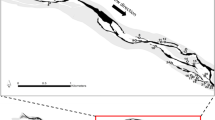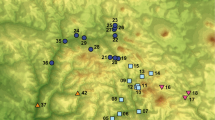Abstract
We assess the probability and importance of different spatial distributions ofPhragmites australis (Trin Ex Steud) within brackish tidal marshes of the mid-Atlantic United States coast. The comparative impact ofPhragmites expansion on the larger coupled marsh-estuary system may partially be a function of the landscape area dominated byPhragmites, the landscape position occupied byPhragmites, the landscape pattern created byPhragmites expansions, and the resulting impact on tidal drainage networks. We find evidence thatPhragmites establishment can occur at many landscape positions, and thatPhragmites spread within a marsh can occur via colonization (new patches), linear clonal growth (along a preferred axis), or circular clonal growth (non-directional, random spread). Early intervals ofPhragmites spread were dominated by colonization for all sites except for Piermont Marsh (which appeared to be dominated by linear clonal growth) and Lang Tract (which appeared to be dominated by circular clonal growth). Although 46–100% of new patches ofPhragmites occurred within 5 m of drainages, at only one site (Piermont Marsh, New York) didPhragmites populations remain concentrated along creek banks. Except for Iona Island, New York, which appears to be in an early stage ofPhragmites invasion, patch dynamics at all sites showed an increase followed by a decrease in patch number, as independent patches became established, expanded, and coalesced. We also found some evidence for a loss of first order streams at later stages ofPhragmites invasions in several sites (Hog Island, Lang Tract, Silver Run).
Similar content being viewed by others
Literature Cited
Able, K. W. andS. M. Hagan. 2000. Effects of common reed (Phragmites australis) invasion on marsh surface macrofauna: Response of fishes and decapod crustaceans.Estuaries 23:644–646.
Able, K. W. andS. M. Hagan. 2003. The impact of common reed,Phragmites australis, on essential fish habitat: Influence on reproduction, embryological development and larval abundance of mummichog (Fundulus heteroclitus).Estuaries 26: 40–50.
Angradi, T. R., S. M. Hagan, andK. W. Able. 2001. Vegetation type and the intertidal macroinvertebrate fauna of a brackish marsh:Phragmites vs.Spartina.Wetlands 21:75–92.
Bart, D. J. 1997. The use of local knowledge in understanding ecological change: A study of salt hay farmers' knowledge ofPhragmites australis invasion. M.A. Thesis, Rutgers University, New Brunswick, New Jersey.
Bart, D. andJ. M. Hartman. 2000. Environmental determinants ofPhragmites australis expansion in a New Jersey salt marsh: An experimental approach.Oikos 89:59–69.
Chambers, R. M. 1997. Porewater chemistry ofPhragmites andSpartina in a Connecticut tidal marsh.Wetlands 17:360–367.
Chambers, R. M., L. A. Meyerson, andK. Saltonstall. 1999. Expansion ofPhragmites australis into tidal wetlands of North America.Aquatic Botany 64:261–273.
Fell, P. E., S. P. Weissbach, D. A. Jones, M. A. Fallon, J. A. Zepieri, E. K. Faston, K. A. Lennon, K. J. Newberry, andL. K. Reddington. 1998. Does invasion of oligohaline tidal marshes by reed grass,Phragmites australis (Cav.) Trin. ex Steud., affect the availability of prey sources for the mummichog,Fundulus heteroclitus L.Journal of Experimental Marine Biology and Ecology 222:59–77.
Howes, B. L. andD. D. Goehringer. 1994. Porewater drainage and dissolved organic carbon and nutrient losses through intertidal creekbanks of a New England salt marsh.Marine Ecology Progress Series 114:289–301.
Kneib, R. T. 1997. The role of tidal marshes in the ecology of estuarine nekton.Oceanography and Marine Biology: An Annual Review 35:163–220.
Lathrop, R. G., M. B. Cole, andR. D. Showalter. 2000. Quantifying the habitat structure and spatial pattern of New Jersey (USA) salt marshes under different management regimes.Wetlands Ecology and Management 8:163–172.
Meyerson, L. A., K. A. Vogt, andR. M. Chambers. 2000. Linking the success ofPhragmites to the decoupling of ecosystem nutrient cycles, p. 817–834.In M. P. Weinstein and D. A. Kreeger (eds.), Concepts and Controversies in Tidal Marsh Ecology. Kluwer Academic Press, Amsterdam, The Netherlands.
Niering, W. A. andR. S. Warren. 1980. Vegetation patterns and processes in New England salt marshes.BioScience 30:301–307.
Orson, R. A., R. S. Warren, andW. A. Niering. 1987. Development of a tidal marsh in a New England river valley.Estuaries 10:20–27.
Ratsep Group, Inc. 1999.Phragmites Migration, Appendix G. PSE&G Renewal Application, Exhibit G-2-17. Salem Generating Station, Elsinboro, New Jersey.
Rice, D., J. Rooth, andJ. C. Stevenson. 2000. Colonization and expansion ofPhragmites australis in upper Chesapeake Bay tidal marshes.Wetlands 20:280–299.
Roman, C. T. 1978. Tidal restriction: Its impact on the vegetation of six Connecticut coastal marshes. M.A. Thesis, Connecticut College, New London, Connecticut.
Rooth, J. E. andJ. C. Stevenson. 2000. Sediment deposition patterns inPhragmites australis communities: Implications for coastal areas threatened by rising sea-level.Wetlands Ecology and Management 8:173–183.
Wainright, S. C., M. P. Weinstein, K. W. Able, andC. A. Currin. 2000. Relative importance of benthic microalgae, phytoplankton and the detritus of smooth cordgrass (Spartina) and the common reed (Phragmites) to brackish marsh food webs.Marine Ecology Progress Series 200:77–91.
Warren, R. S. and P. E. Fell. 1996.Phragmites australis on the lower Connecticut River: Impacts on emergent wetlands and estuarine waters. Final report to the CT DEP Office of Long Island Sound Programs, Hartford, Connecticut.
Warren, R. S., P. E. Fell, J. L. Grimsby, E. L. Buck, C. G. Rilling, andR. A. Fertik. 2001. Rates, patterns, and impacts ofPhragmites australis expansion and effects of experimentalPhragmites control on vegetation, macroinvertebrates, and fish within tidelands of the Lower Connecticut River.Estuaries 24: 90–107.
Weinstein, M. P. andJ. H. Balleto. 1999. Does the common reed,Phragmites australis, affect essential fish habitat?Estuaries 22:793–802.
Windham, L. 1999. Effects of an invasive reedgrass,Phragmites australis, on nitrogen cycling in brackish tidal marsh of New York and New Jersey. Ph.D. Dissertation Rutgers University, New Brunswick, New Jersey.
Windham, L. 2001. Comparison of biomass production and decomposition betweenPhragmites australis (common reed) andSpartina patens (salt hay) in brackish tidal marsh of New Jersey.Wetlands 21:179–188.
Windham, L. and J. Ehrenfeld. In press. Conflicting effects and the net impact of a plant invasion on nitrogen cycling processes within brackish tidal marshes.Ecological Applications
Windham, L. andR. G. Lathrop. 1999. Effects ofPhragmites australis (common reed) invasion on aboveground biomass and soil properties in brackish tidal marsh on the Mullica River, New Jersey.Estuaries 22:927–935.
Windham, L., J. Weis, andP. Weis. 2001. Patterns and processes of mercury (Hg) release from leaves of two dominant salt marsh plants:Spartina alterniflora (salt cordgrass) andPhragmites australis (common reed).Estuaries 24:787–795.
Winogrand, H. G. andE. Kiviat. 1997. Invasion ofPhragmites australis in the tidal marshes of the Hudson River, p. 1–29.In W. C. Nieder and J. R. Waldman (eds.), Final Reports of the Tibor T. Polgar Fellowship Program, 1996. Hudson River Foundation, New York.
Sources of Unpublished Materials
Nieder, C. Personal Communication. Hudson River National Estuarine Research Reserve, c/o Bard College Field Station, Annandale, New York 12504.
Strait, K. Personal Communication. PSE&G Estuary Enhancement Program, 130 Money Island Road, Elsinboro, New Jersey 08079.
Author information
Authors and Affiliations
Corresponding author
Rights and permissions
About this article
Cite this article
Lathrop, R.G., Windham, L. & Montesano, P. DoesPhragmites expansion alter the structure and function of marsh landscapes? Patterns and processes revisited. Estuaries 26, 423–435 (2003). https://doi.org/10.1007/BF02823719
Received:
Revised:
Accepted:
Issue Date:
DOI: https://doi.org/10.1007/BF02823719




